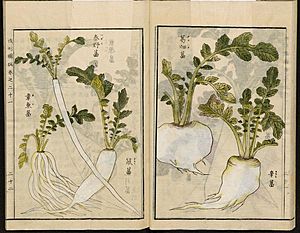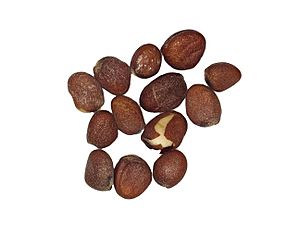Daikon facts for kids
Quick facts for kids Daikon |
|
|---|---|
 |
|
| Genus | Raphanus |
| Species | Raphanus sativus |
| Subspecies | R. sativus subsp. longipinnatus |
| Cultivar group | White radish |
| Origin | North China |
| Daikon Radish | |||||||||
|---|---|---|---|---|---|---|---|---|---|

Radishes in Okage Yoko-chō, Japan
|
|||||||||
| Chinese name | |||||||||
| Traditional Chinese | 白蘿蔔 | ||||||||
| Simplified Chinese | 白萝卜 | ||||||||
| Literal meaning | "White radish " | ||||||||
|
|||||||||
| Korean name | |||||||||
| Hangul | 왜무 | ||||||||
| Literal meaning | Wae radish | ||||||||
|
|||||||||
| Japanese name | |||||||||
| Kanji | 大根 | ||||||||
| Kana | だいこん | ||||||||
|
|||||||||
Daikon (pronounced DYE-kon) is a type of radish. Its name means 'big root' in Japanese. It's also called mooli. This mild-tasting winter vegetable has long, white roots and fast-growing leaves.
Daikon first grew in East Asia. Today, people grow and eat it all over Asia and the world. Sometimes, farmers plant daikon to help the soil. They don't always harvest it for food.
Contents
What's in a Name?
The most common names for this vegetable in English are daikon or daikon radish. In places with ties to South Asia, like India, it's often called mooli. This name comes from Hindi and Punjabi languages.
You might also hear it called white radish, winter radish, or Oriental radish. If you need to be specific, you can say Japanese radish.
Daikon's Chinese and Korean Names
In China, it's usually called báiluóbo, which means Chinese white radish. In some Chinese areas, like Hong Kong, it's known as lobak or lo pak. This is a Cantonese word for radish or carrot.
In Singapore and Taiwan, it might be called chai tow or chai tau. Sometimes, people just call it "radish." In English-speaking countries, it's also sold as icicle radish.
Daikon in Farming
In North America, daikon is often grown for farming, not for food. It helps prevent soil from getting too hard. The leaves can be used to feed animals. The United States Department of Agriculture calls it oilseed radish when it's used this way. Other farming names include "forage radish" or "tillage radish."
Daikon's Many Looks
Most daikon are white, but there are other colors too. Some Chinese daikon, called lobak, have a light green top near the leaves. The Korean radish, or mu, also has a pale green top. These are usually shorter and thicker than the long white daikon. They can also be spicier.
There's a special Chinese daikon called the watermelon radish. It looks dull green on the outside. But when you slice it, the inside is a bright pink or fuchsia color! Its Chinese name means "beauty heart" or "beautiful heart inside."
Growing Daikon
Daikon varieties from China and India can handle warmer weather than Japanese ones. They also grow well in lower areas of East Africa. Daikon grows quickly if it gets enough water. If not, it can become tough and very spicy.
You can store daikon roots for a few weeks if you keep them cool and dry. It's best to remove the leaves first. If left in the ground too long, the roots can become woody.
Daikon as a Cover Crop
Some types of daikon are grown as a "cover crop" in winter. This means they cover the soil to protect it. They are also called "tillage radish." This is because their huge roots grow deep into the soil. This helps break up hard soil, making it easier for other crops to grow later.
Daikon roots also help the soil hold onto important nutrients. These nutrients might otherwise wash away. When the daikon roots break down, they release these nutrients back into the soil. This can help future crops grow better and reduce the need for extra fertilizer. Farmers in places like Prince Edward Island use tillage radish to help their potato crops.
Daikon is also used as animal feed around the world. It can even help control weeds in fields.
Daikon in the Kitchen
Daikon is a popular ingredient in many dishes, especially in Asian cooking.
Japanese Dishes
In Japan, daikon roots are used to make many types of pickles, like takuan. You can eat daikon raw in salads. It's also often grated and used as a garnish. Grated daikon, called Daikon-oroshi, is mixed into dipping sauces like ponzu. A spicy pink version, momiji-oroshi, is made with chili pepper.
Daikon is also popular in simmered dishes, like oden. Dried, shredded daikon is called kiriboshi-daikon. Daikon sprouts, kaiware-daikon, are used raw in salads or as a garnish for sashimi. Daikon leaves are also eaten as a green vegetable. They can be a bit prickly when raw, so they are often pickled or stir-fried.
Chinese Dishes
In Chinese cuisine, daikon is used to make turnip cake and chai tow kway. It's called bailuobo in Mandarin or lobak in Cantonese. Bailuobo is used in many soups, like bailuobo-paigu soup (with pork ribs). It's also made into popular home dishes like "shredded bailuobo." Just like in Japan, many types of pickles are made with bailuobo.
Indian and South Asian Dishes
In North India, daikon is used in sabzi (vegetable dishes), stuffed breads called paranthas, and fried snacks called pakodas. It's also used in salads and pickles. The leaves are used to make dishes like dal.
In South India, daikon is a main ingredient in a stew called sambar. This soup, called mullangi sambar, is very popular.
Other Asian Dishes
In Vietnamese cuisine, sweet and sour pickled daikon and carrots are a common side dish for bánh mì sandwiches. In the Philippines, daikon, known as labanos, can be found in the sour stew sinigang.
In Pakistan, young daikon leaves are cooked with spices. The radish itself is eaten fresh in salads. Daikon's seed pods, called moongray, are also stir-fried. In Bangladesh, grated daikon is mixed with chili, fish, and lime juice to make a dish called mulo bhorta.
Nutritional Value
Daikon is very low in calories. A small serving (100 grams) has only 18 Calories. But it gives you a lot of vitamin C! It also contains a helpful enzyme called myrosinase.
Other Uses
Daikon is also used to prepare metal surfaces. This is done before certain chemical treatments, like the Rokushō process.
Images for kids
-
Chai tow kway, stir-fried cubes of radish cake
-
Japanese mizuna and daikon salad













